|
Rain, and Upcoming Practice Green Renovation...
Josh Clevenger, Claremont Country Club, Oakland, CA:
 "I sit and write this morning (10/22) with a smile on my face that has not been seen for five months. Yes, it's been FIVE long months since the last significant rainfall. If there is anything that can put a smile on the face of the California superintendent, it's the first rain of the season.
While I'm happy to see the rain for now, we hope to get a break over the next few weeks so we can finish the tournament season strong and complete our fall cultural maintenance on the course.
" All of these issues together have resulted in poor turf quality on the most visible green on the property..." |
Beginning October 31 we will be renovating the practice putting green at the clubhouse/1st tee area. As we have all seen over the last two seasons, this greens continues to be the most problematic in both the winter and summer seasons due to poor draining soils, irrigation inconsistencies, tree shade and root competition and high levels of foot traffic. All of these issues together have resulted in poor turf quality on the most visible green on the property. With this project, we will address as many of the issues as possible. Work is to be performed as follows:
- Existing turf will be removed and stored on site
- Good sand/soil (greens mix) will be removed and stockpiled on site
- Poor soils and clay removed and a "greens cavity" shaped into the sub-grade
- Extensive drainage system installed into the sub-grade
- 75 tons of new sand blended with our greens mix to fill cavity, compact and finish grade
- Replace sod and grow-in the renovated putting green!
The result here will be a practice green that drains well during and after heavy rain events and performs to our expectation throughout the long growing season that is typical here in California. Please plan on the construction to take at least two weeks and then another 4 to 6 weeks to grow in to the point that it will hold up to maintenance and member traffic. The timing will depend greatly on the weather."
Visit Josh's blog at claremontturf.blogspot.com.
|
 |
|
Chipping Green Renovation Update...
Justin Ruiz, CGCS MG, Indian Summer Golf & Country Club, Olympia, WA:
 "The chipping green at the practice facility was not a good representation of the golf course this last year. We decided to make use of our aerification plugs from the greens to renovate the small chipping green.
We redesigned the chipping green to have three separate tiers and nearly double the square footage. The reason for the larger size was to give us the ability to use a portion for a nursery if we needed. We also wanted to make it possible to practice a variety of different shots around the green.
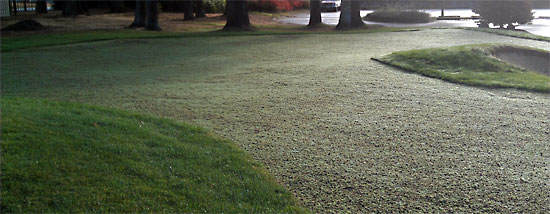
The green is coming along really well and we are planning our first cut very soon."
Visit Justin's blog at indiansummergolf.blogspot.com.
|
 |
|
Bridge Work Update...
David Smith, Fawn Lake Country Club, Spotsylvania, VA:

|
 "Bridges will continue to be a focus of effort until they are completely cleaned, stained, and repaired. The work is very labor intensive and time consuming. Trying to do it in a way that doesn't interfere with play is tricky at best.
We have 1,100 linear feet of bridges totaling 11,000 square feet (1/4 acre) of bridge deck, not including the railings. The lumber is a true 3" x 8" x 10' and does not come cheap. Structurally, the bridges are very sound, but cosmetically there is some obvious work to be done.
The bridges at 6, 7, 8, 9, and 18 have been cleaned and are soon to be stained (hopefully today). The bridge at 10 has been completed and the bridges at 2, 4, 12, 16, and 17 will be done as weather and golf schedules allow. We'll be making some board replacements as needed during the course of the fall and winter. We'll continue to work on them until completed and try our best not to disturb play."
Visit David's blog at flccturfcare.blogspot.com.
|
 |
|
Soil Management...
Craig DeJong, Hendersonville (NC) Country Club:
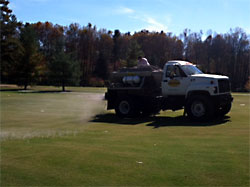
The application process (above), and
a fresh dusting of lime (below).
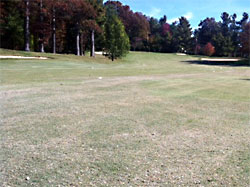
|
 "Two years ago we applied lime to the golf course and the results have been fantastic. Soil tests indicated that our soils were holding a lot of nutrition that was unavailable to the plant, and the pH of our soil was low.
pH is the most commonly measured property of soil, measuring the acidity or alkalinity of soil. pH numbers range from 4 to 10 with 4 being acidic, 10 being alkaline, and 7 being neutral. The ideal number we are looking to achieve, based on our soil type, is 5.5-6.5. The benefits of a correct pH are numerous and can include; increased plant and root function and microbiological activity.
The best way for us to gauge the effectiveness of these applications came this summer. As our soils became more balanced, bound up nutrition became available to the plant and we decreased our applications of fertility. The plant was using what the soil was giving it."
Visit Craig's blog at hccgcgd.blogspot.com.
|
 |
|
ECO-TEA Biological Soil Amendment...
Jason Hooper, Quilchena Golf & Country Club, Quilchena, BC:
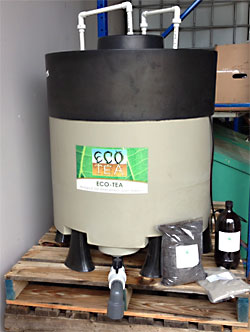
ECO-TEA brewing kit
|
 "Earlier this year I heard about a product named ECO-TEA: a cost effective, 100% organic product could be safely applied to turf, shrubs, trees, roses and other plant material to help develop healthy root systems and improve disease resistance among other things.
I have to admit, having heard about products that pledge to do all these wonderful things time and time again, I was more than a bit skeptical. The golf season and turf maintenance season for that matter was in full swing so ECO-TEA quickly took a spot on the back burner. It wasn't until now that I've have had some time to really research the product for myself."
So what is ECO-TEA, you ask? Here is some information right from the product developer's website:
- ECO-TEA is an aerated compost tea (ACT), derived from night-crawler castings, high-grade compost, kelp, humic and fulvic acids with addition of bio-activator compounds.
- In addition to soluble nutrients, our earthworm castings and compost contain a diverse compliment of beneficial soil microorganisms (bacteria, fungi and micro-invertebrates) which are extracted into the tea.
- Adding these ingredients to highly oxygenated water increases biological activity and over a 24–36 hour period the organisms in the ECO-TEA reproduce to great population sizes.
What are the benefits of ECO-TEA?
- The main benefit of ECO-TEA comes from the soil microorganisms, which aid in nutrient turnover, improve soil structure, increase water retention and most importantly increases disease resistance in your soil and on your plants.
- ECO-TEA contains many soluble nutrients including Calcium, Magnesium, Iron, Zinc and Copper. All are found in sufficient quantities for optimum plant growth.
We are now using ECO-TEA as part of our turf and plant health programs throughout the property. We have a 50-gallon brewing kit on-site so we can brew the tea compost whenever we chose to do so. The brewing process takes 24 hours and once brewed, with continuous aeration, the ECO-TEA lasts for 5-7 days for spray applications. We are excited to see the results from using this environmentally-friendly product to provide healthier and stronger plants that will be able to fight off disease and other pests and reduce our pesticide use.
Here are a few photos of the brewing and application process:
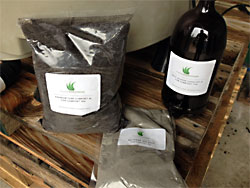
ECO-TEA ingredients: compost, nutrient mix, catalyst
| 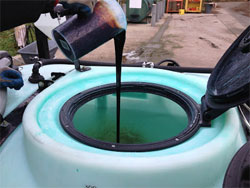
adding the catalyst prior to adding the tea compost & nutrient mix
| 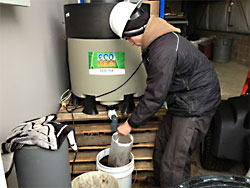
tea compost & nutrient mix is filtered before adding to spray tank
| 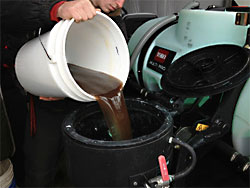
tea compost & nutrient mix added to the spray tank
|
Again, this product is not only for turf. Head Horticulturist, Jacqui, is excited about using it on the landscaping plant material throughout the property. We will also be applying it to our newer trees on the course to promote healthy roots and help them become less susceptible to pests.
As with most plant health products, commitment and repeated use is necessary to achieve optimal results. We will be carefully documenting the the use of this product and will share the results sometime next year."
Visit Jason's blog at qgolfclub.blogspot.com/
|
 |
|
Prepping Greens for a Better Tomorrow...
Mark Kienert, CGCS, Bulls Eye Country Club, Wisconsin Rapids, WI:

"Bull's Eye putting surfaces have been deep-tined for the first time since 2005, choosing to use Champion Greens from Sheboygan Falls, Wisconsin. This is my first experience working with them and from this experience I would use them again. Seven total hours to tine twenty greens. (Note: Tri City greens were not deep tined this year and will serve as our check.)
I've always considered deep tining to be a drainage event more so than an aerification event, but this time around I'm asking for deeper and better rooting of the plants on our greens as the primary benefit. Rooting should continue well into the winter until the point in time the soil freezes up.
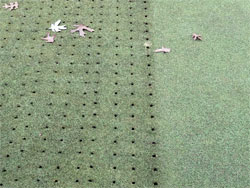
|
Greens were tined to a depth of eight inches to facilitate air and water movement into and through the soil profile. I've noted a slight layer build up I believe came as a result of winter-killed turf that occurred both winters of 2004 and 2005.
Taking advantage of open tine holes and the need for additional sand incorporation, greens were spiked with one half inch solid tines using our greens aerifier. Our second aerification of the year was all but cancelled due to the massive interseeding of greens undertaken the first weeks of August.
I wasn't sure we could pull this aerification off as I had a complement of six men counting myself on hand to both clean up a messy golf course after a weekends worth of leaf drop and the requirement to fill jobs like topdressing, dragging and rolling... all operations that go with any aerification event.
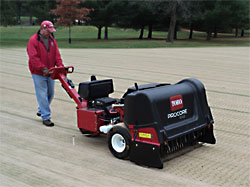
|
I volunteered to operate the aerifier as a change of pace as I've become tired of the multiple trips to and from the sand silo from past seasons to topdress greens. Stupid me! Eight straight hours of walking backwards and my cramping feet reminded me that I was no longer 24! I did manage to complete 16 of twenty greens, not a bad days work. I estimated I walked backwards over 16 miles. My legs and feet felt like mush!"
Visit Mark's blog at bullseyegreensblog.blogspot.com.
|
 |
|
On a Completely Unrelated Note...
Chris Tritabaugh, Northland Country Club, Duluth, MN:
 "I got to cross an item off my 'bucket list' on Saturday. I attended a Manchester United match at Old Trafford in Manchester, England. If you have never been to a football match in England, I highly recommend; even if you are not a fan of the sport. It is an experience I will never forget.
In the photo you can see the sprinklers running, just minutes before the start of the match. Players like the surface to be a little bit wet as it helps the ball move smoothly across the turf.
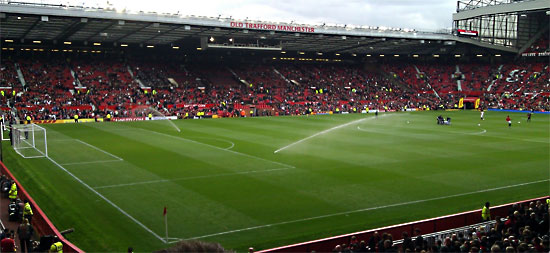
As someone who manages a living playing surface; I find it fascinating to learn how playing surfaces in other sports are managed according to players desires."
Visit Chris's blog at northlandgrounds.blogspot.com.
|
 |
 |
|
About our Blog Aggregator: Many superintendents are now hosting private blogs to better communicate with their golfers and/or members. Beyond local weather and course conditions, there is a great deal of information about projects, methodologies and techniques that would be of value to other superintendents — hence our Turf Blog Aggregator. As every blogger struggles occasionally with content, we also include posts intended to educate golfers about turf maintenance for others to use as a template for their own blogs.
Miss any previous issues of TBA? You can find them all here.
Turf Blog Aggregator(TM) is a trademark of Turnstile Media Group.
|
|